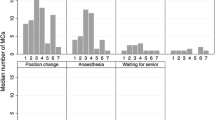Abstract
Background
Performing minimally invasive surgery (MIS) in a conventional operating room (OR) requires additional specialized equipment otherwise stored outside the OR. Before the procedure, the OR team must collect, prepare, and connect the equipment, then take it away afterward. These extra tasks pose a thread to OR efficiency and may lengthen turnover times. The dedicated MIS suite has permanently installed laparoscopic equipment that is operational on demand. This study presents two experiments that quantify the superior efficiency of the MIS suite in the interoperative period.
Methods
Preoperative setup and postoperative breakdown times in the conventional OR and the MIS suite in an experimental setting and in daily practice were analyzed. In the experimental setting, randomly chosen OR teams simulated the setup and breakdown for a standard laparoscopic cholecystectomy (LC) and a complex laparoscopic sigmoid resection (LS). In the clinical setting, the interoperative period for 66 LCs randomly assigned to the conventional OR or the MIS suite were analyzed.
Results
In the experimental setting, the setup and breakdown times were significantly shorter in the MIS suite. The difference between the two types of OR increased for the complex procedure: 2:41 min for the LC (p < 0.001) and 10:47 min for the LS (p < 0.001). In the clinical setting, the setup and breakdown times as a whole were not reduced in the MIS suite. Laparoscopic setup and breakdown times were significantly shorter in the MIS suite (mean difference, 5:39 min; p < 0.001).
Conclusion
Efficiency during the interoperative period is significantly improved in the MIS suite. The OR nurses’ tasks are relieved, which may reduce mental and physical workload and improve job satisfaction and patient safety. Due to simultaneous tasks of other disciplines, an overall turnover time reduction could not be achieved.


Similar content being viewed by others
References
Alarcon A, Berguer R (1996) A comparison of operating room crowding between open and laparoscopic operations. Surg Endosc 10:916–919
Herron DM, Gagner M, Kenyon TL, Swanstrom LL (2001) The minimally invasive surgical suite enters the 21st century: a discussion of critical design elements. Surg Endosc 15:415–422
Kenyon TA, Urbach DR, Speer JB, Waterman-Hukari B, Foraker GF, Hansen PD, Swanstrom LL (2001) Dedicated minimally invasive surgery suites increase operating room efficiency. Surg Endosc 15:1140–1143
Van Det MJ, Meijerink WJHJ, Hoff C, Van Veelen MA, Pierie JPEN (2008) Ergonomic assessment of neck posture in the minimally invasive surgery suite during laparoscopic cholecystectomy. Surg Endosc 22:2421–2427
Verdaasdonk EG, Stassen LP, van der EM, Karsten TM, Dankelman J (2007) Problems with technical equipment during laparoscopic surgery: an observational study. Surg Endosc 21:275–279
Luketich JD, Fernando HC, Buenaventura PO, Christie NA, Grondin SC, Schauer PR (2002) Results of a randomized trial of HERMES-assisted versus non–HERMES-assisted laparoscopic antireflux surgery. Surg Endosc 16:1264–1266
Van Veelen MA, Jakimowicz JJ, Goossens RH, Meijer DW, Bussmann JB (2002) Evaluation of the usability of two types of image display systems, during laparoscopy. Surg Endosc 16:674–678
Erfanian K, Luks FI, Kurkchubasche AG, Wesselhoeft CW Jr, Tracy TF Jr (2003) In-line image projection accelerates task performance in laparoscopic appendectomy. J Pediatr Surg 38:1059–1062
Van Det MJ, Meijerink WJHJ, Hoff C, Totte ER, Pierie JPEN (2008) Optimal ergonomics for laparoscopic surgery in minimally invasive surgery suites: a review and guidelines. Surg Endosc, October 2, Epub ahead of print
Acknowledgments
We thank J. M. P. Collins for reviewing the text and B. Middel for advising in statistical methodology.
Author information
Authors and Affiliations
Corresponding author
Rights and permissions
About this article
Cite this article
van Det, M.J., Meijerink, W.J.H.J., Hoff, C. et al. Interoperative efficiency in minimally invasive surgery suites. Surg Endosc 23, 2332–2337 (2009). https://doi.org/10.1007/s00464-009-0335-4
Received:
Revised:
Accepted:
Published:
Issue Date:
DOI: https://doi.org/10.1007/s00464-009-0335-4




